2006 CHEVROLET AVEO child restraint
[x] Cancel search: child restraintPage 72 of 362

The passenger sensing system works with a sensor
that is part of the right front passenger’s seat cushion.
The sensor is designed to detect the presence of a
properly-seated occupant and determine if the
passenger’s frontal airbag and side impact airbag
(if equipped) should be enabled (may inflate) or not.
Accident statistics show that children are safer if
they are restrained in the rear, rather than the front
seat. General Motors recommends that child restraints
be secured in a rear seat, including an infant riding
in a rear-facing infant seat, a child riding in a
forward-facing child seat, and an older child riding in a
booster seat.
Your vehicle has a rear seat that will accommodate a
rear-facing child restraint. A label on your sun visor says,
“Never put a rear-facing child seat in the front.” This
is because the risk to the rear-facing child is so great,
if the airbag deploys.
{CAUTION:
A child in a rear-facing child restraint can be
seriously injured or killed if the right front
passenger’s airbag in�ates. This is because
the back of the rear-facing child restraint
would be very close to the in�ating airbag.
Even though the passenger sensing system is
designed to turn off the passenger’s frontal
airbag and side airbag (if equipped) if the
system detects a rear-facing child restraint, no
system is fail-safe, and no one can guarantee
that an airbag will not deploy under some
unusual circumstance, even though it is turned
off. General Motors recommends that
rear-facing child restraints be secured in the
rear seat, even if the airbag or airbags are off.
If you need to secure a forward-facing child
restraint in the right front seat, always move
the front passenger seat as far back as it will
go. It is better to secure the child restraint in a
rear seat.
1-66
Page 73 of 362
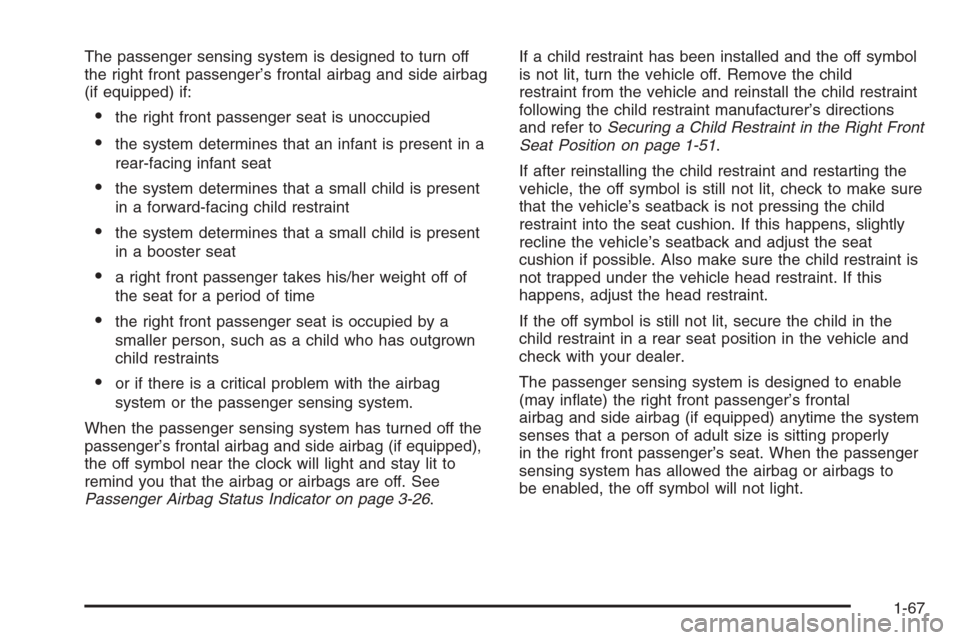
The passenger sensing system is designed to turn off
the right front passenger’s frontal airbag and side airbag
(if equipped) if:
•the right front passenger seat is unoccupied
•the system determines that an infant is present in a
rear-facing infant seat
•the system determines that a small child is present
in a forward-facing child restraint
•the system determines that a small child is present
in a booster seat
•a right front passenger takes his/her weight off of
the seat for a period of time
•the right front passenger seat is occupied by a
smaller person, such as a child who has outgrown
child restraints
•or if there is a critical problem with the airbag
system or the passenger sensing system.
When the passenger sensing system has turned off the
passenger’s frontal airbag and side airbag (if equipped),
the off symbol near the clock will light and stay lit to
remind you that the airbag or airbags are off. See
Passenger Airbag Status Indicator on page 3-26.If a child restraint has been installed and the off symbol
is not lit, turn the vehicle off. Remove the child
restraint from the vehicle and reinstall the child restraint
following the child restraint manufacturer’s directions
and refer toSecuring a Child Restraint in the Right Front
Seat Position on page 1-51.
If after reinstalling the child restraint and restarting the
vehicle, the off symbol is still not lit, check to make sure
that the vehicle’s seatback is not pressing the child
restraint into the seat cushion. If this happens, slightly
recline the vehicle’s seatback and adjust the seat
cushion if possible. Also make sure the child restraint is
not trapped under the vehicle head restraint. If this
happens, adjust the head restraint.
If the off symbol is still not lit, secure the child in the
child restraint in a rear seat position in the vehicle and
check with your dealer.
The passenger sensing system is designed to enable
(may inflate) the right front passenger’s frontal
airbag and side airbag (if equipped) anytime the system
senses that a person of adult size is sitting properly
in the right front passenger’s seat. When the passenger
sensing system has allowed the airbag or airbags to
be enabled, the off symbol will not light.
1-67
Page 74 of 362

For some children who have outgrown child restraints
and for very small adults, the passenger sensing system
may or may not turn off the right front passenger’s
frontal airbag and side airbag (if equipped), depending
upon the person’s seating posture and body build.
Everyone in your vehicle who has outgrown child
restraints should wear a safety belt properly — whether
or not there is an airbag for that person.
If a person of adult-size is sitting in the right front
passenger’s seat, but the off symbol is lit, it could be
because that person is not sitting properly in the seat.
If this happens do the following:
Turn the vehicle off and ask the person to place the
seatback in the fully upright position, then sit upright in
the seat, centered on the seat cushion, with the
person’s legs comfortably extended. Restart the vehicle
and have the person remain in this position for about
two minutes. This will allow the system to detect
that person and then enable the passenger’s airbag or
airbags.
1-68
Page 75 of 362
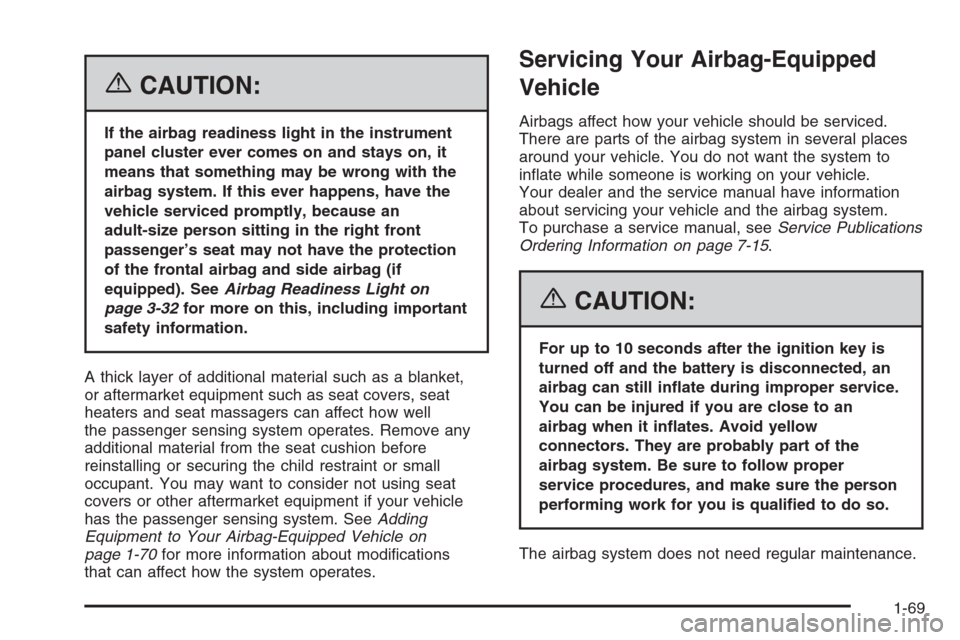
{CAUTION:
If the airbag readiness light in the instrument
panel cluster ever comes on and stays on, it
means that something may be wrong with the
airbag system. If this ever happens, have the
vehicle serviced promptly, because an
adult-size person sitting in the right front
passenger’s seat may not have the protection
of the frontal airbag and side airbag (if
equipped). SeeAirbag Readiness Light on
page 3-32for more on this, including important
safety information.
A thick layer of additional material such as a blanket,
or aftermarket equipment such as seat covers, seat
heaters and seat massagers can affect how well
the passenger sensing system operates. Remove any
additional material from the seat cushion before
reinstalling or securing the child restraint or small
occupant. You may want to consider not using seat
covers or other aftermarket equipment if your vehicle
has the passenger sensing system. SeeAdding
Equipment to Your Airbag-Equipped Vehicle on
page 1-70for more information about modifications
that can affect how the system operates.
Servicing Your Airbag-Equipped
Vehicle
Airbags affect how your vehicle should be serviced.
There are parts of the airbag system in several places
around your vehicle. You do not want the system to
inflate while someone is working on your vehicle.
Your dealer and the service manual have information
about servicing your vehicle and the airbag system.
To purchase a service manual, seeService Publications
Ordering Information on page 7-15.
{CAUTION:
For up to 10 seconds after the ignition key is
turned off and the battery is disconnected, an
airbag can still in�ate during improper service.
You can be injured if you are close to an
airbag when it in�ates. Avoid yellow
connectors. They are probably part of the
airbag system. Be sure to follow proper
service procedures, and make sure the person
performing work for you is quali�ed to do so.
The airbag system does not need regular maintenance.
1-69
Page 140 of 362
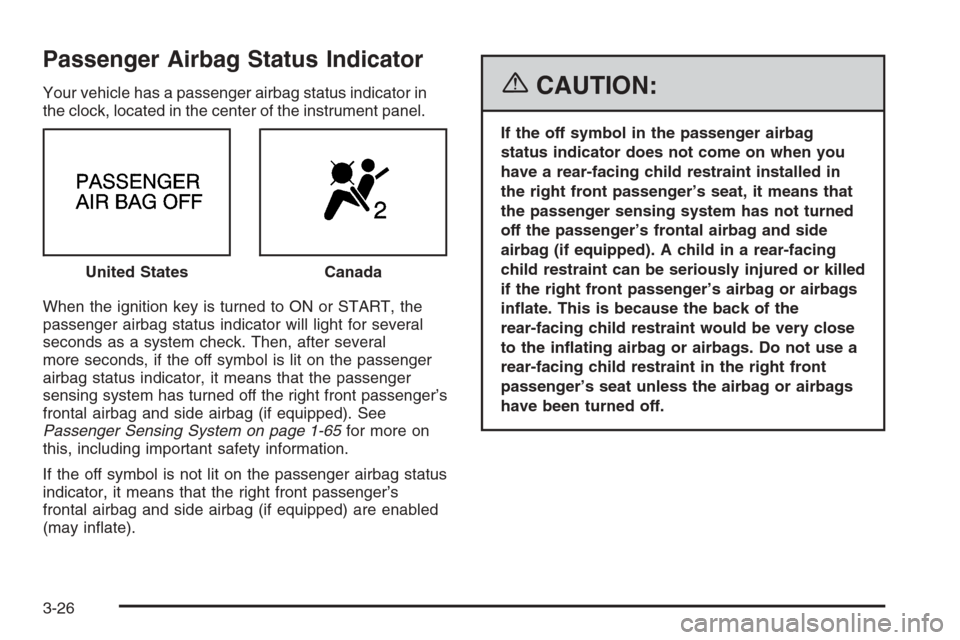
Passenger Airbag Status Indicator
Your vehicle has a passenger airbag status indicator in
the clock, located in the center of the instrument panel.
When the ignition key is turned to ON or START, the
passenger airbag status indicator will light for several
seconds as a system check. Then, after several
more seconds, if the off symbol is lit on the passenger
airbag status indicator, it means that the passenger
sensing system has turned off the right front passenger’s
frontal airbag and side airbag (if equipped). See
Passenger Sensing System on page 1-65for more on
this, including important safety information.
If the off symbol is not lit on the passenger airbag status
indicator, it means that the right front passenger’s
frontal airbag and side airbag (if equipped) are enabled
(may inflate).{CAUTION:
If the off symbol in the passenger airbag
status indicator does not come on when you
have a rear-facing child restraint installed in
the right front passenger’s seat, it means that
the passenger sensing system has not turned
off the passenger’s frontal airbag and side
airbag (if equipped). A child in a rear-facing
child restraint can be seriously injured or killed
if the right front passenger’s airbag or airbags
in�ate. This is because the back of the
rear-facing child restraint would be very close
to the in�ating airbag or airbags. Do not use a
rear-facing child restraint in the right front
passenger’s seat unless the airbag or airbags
have been turned off. United States
Canada
3-26
Page 219 of 362
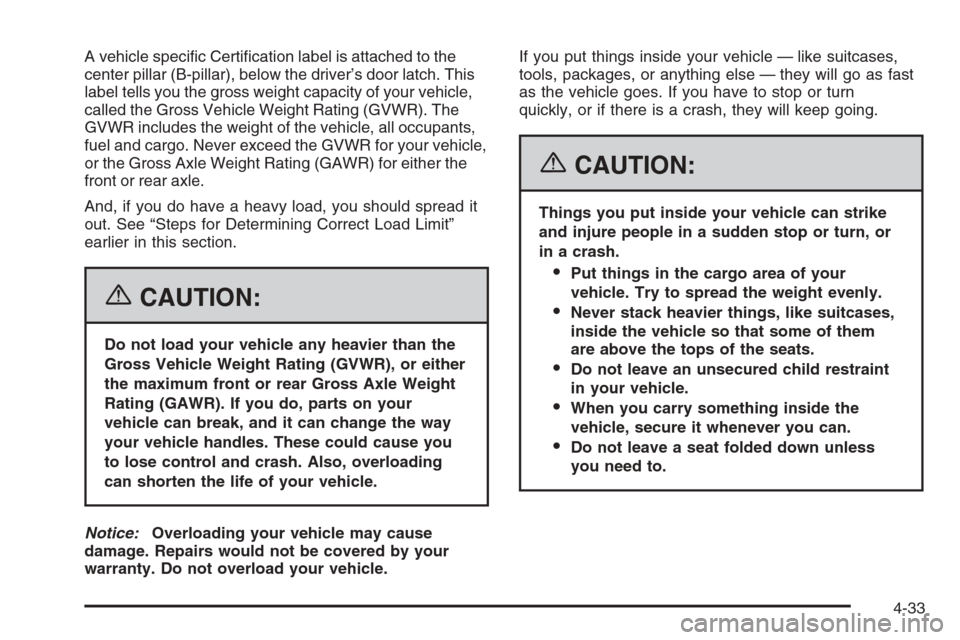
A vehicle specific Certification label is attached to the
center pillar (B-pillar), below the driver’s door latch. This
label tells you the gross weight capacity of your vehicle,
called the Gross Vehicle Weight Rating (GVWR). The
GVWR includes the weight of the vehicle, all occupants,
fuel and cargo. Never exceed the GVWR for your vehicle,
or the Gross Axle Weight Rating (GAWR) for either the
front or rear axle.
And, if you do have a heavy load, you should spread it
out. See “Steps for Determining Correct Load Limit”
earlier in this section.
{CAUTION:
Do not load your vehicle any heavier than the
Gross Vehicle Weight Rating (GVWR), or either
the maximum front or rear Gross Axle Weight
Rating (GAWR). If you do, parts on your
vehicle can break, and it can change the way
your vehicle handles. These could cause you
to lose control and crash. Also, overloading
can shorten the life of your vehicle.
Notice:Overloading your vehicle may cause
damage. Repairs would not be covered by your
warranty. Do not overload your vehicle.If you put things inside your vehicle — like suitcases,
tools, packages, or anything else — they will go as fast
as the vehicle goes. If you have to stop or turn
quickly, or if there is a crash, they will keep going.
{CAUTION:
Things you put inside your vehicle can strike
and injure people in a sudden stop or turn, or
in a crash.
Put things in the cargo area of your
vehicle. Try to spread the weight evenly.
Never stack heavier things, like suitcases,
inside the vehicle so that some of them
are above the tops of the seats.
Do not leave an unsecured child restraint
in your vehicle.
When you carry something inside the
vehicle, secure it whenever you can.
Do not leave a seat folded down unless
you need to.
4-33
Page 352 of 362
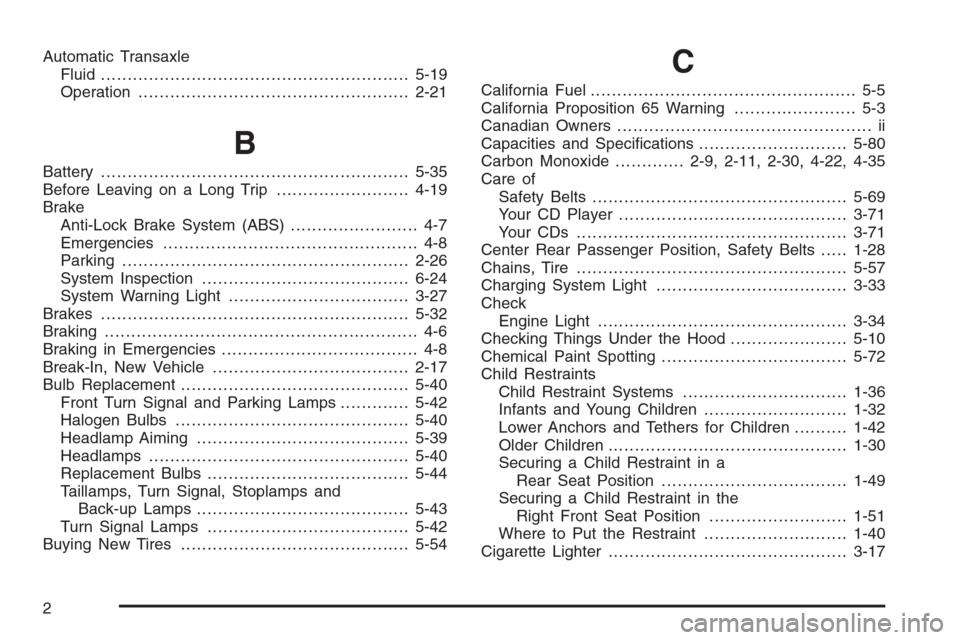
Automatic Transaxle
Fluid..........................................................5-19
Operation...................................................2-21
B
Battery..........................................................5-35
Before Leaving on a Long Trip.........................4-19
Brake
Anti-Lock Brake System (ABS)........................ 4-7
Emergencies................................................ 4-8
Parking......................................................2-26
System Inspection.......................................6-24
System Warning Light..................................3-27
Brakes..........................................................5-32
Braking........................................................... 4-6
Braking in Emergencies..................................... 4-8
Break-In, New Vehicle.....................................2-17
Bulb Replacement...........................................5-40
Front Turn Signal and Parking Lamps.............5-42
Halogen Bulbs............................................5-40
Headlamp Aiming........................................5-39
Headlamps.................................................5-40
Replacement Bulbs......................................5-44
Taillamps, Turn Signal, Stoplamps and
Back-up Lamps........................................5-43
Turn Signal Lamps......................................5-42
Buying New Tires...........................................5-54
C
California Fuel.................................................. 5-5
California Proposition 65 Warning....................... 5-3
Canadian Owners................................................ ii
Capacities and Specifications............................5-80
Carbon Monoxide.............2-9, 2-11, 2-30, 4-22, 4-35
Care of
Safety Belts................................................5-69
Your CD Player...........................................3-71
Your CDs ...................................................3-71
Center Rear Passenger Position, Safety Belts.....1-28
Chains, Tire...................................................5-57
Charging System Light....................................3-33
Check
Engine Light...............................................3-34
Checking Things Under the Hood......................5-10
Chemical Paint Spotting...................................5-72
Child Restraints
Child Restraint Systems...............................1-36
Infants and Young Children...........................1-32
Lower Anchors and Tethers for Children..........1-42
Older Children.............................................1-30
Securing a Child Restraint in a
Rear Seat Position...................................1-49
Securing a Child Restraint in the
Right Front Seat Position..........................1-51
Where to Put the Restraint...........................1-40
Cigarette Lighter.............................................3-17
2
Page 356 of 362
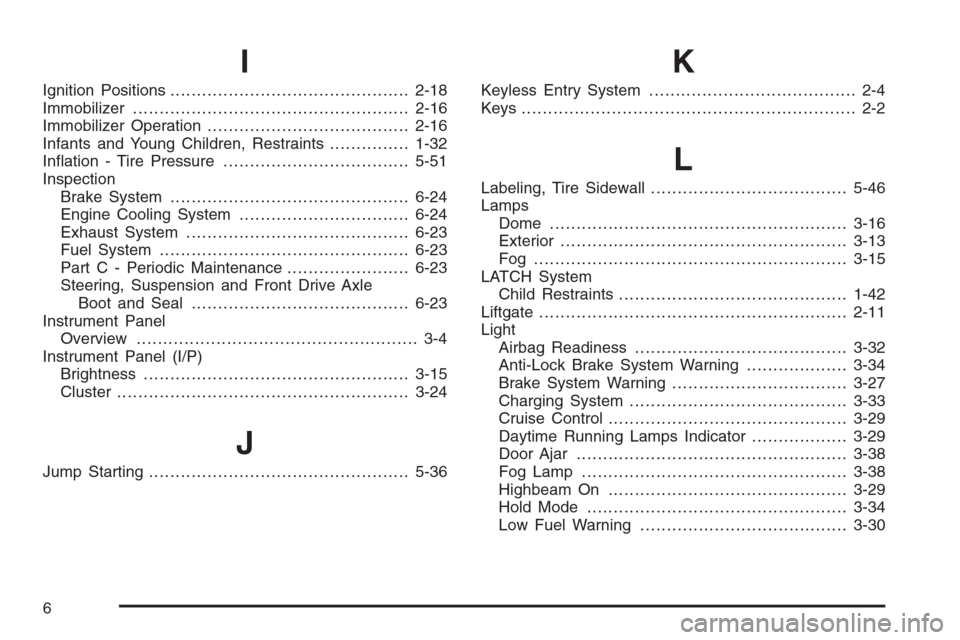
I
Ignition Positions.............................................2-18
Immobilizer....................................................2-16
Immobilizer Operation......................................2-16
Infants and Young Children, Restraints...............1-32
Inflation - Tire Pressure...................................5-51
Inspection
Brake System.............................................6-24
Engine Cooling System................................6-24
Exhaust System..........................................6-23
Fuel System...............................................6-23
Part C - Periodic Maintenance.......................6-23
Steering, Suspension and Front Drive Axle
Boot and Seal.........................................6-23
Instrument Panel
Overview..................................................... 3-4
Instrument Panel (I/P)
Brightness..................................................3-15
Cluster.......................................................3-24
J
Jump Starting.................................................5-36
K
Keyless Entry System....................................... 2-4
Keys............................................................... 2-2
L
Labeling, Tire Sidewall.....................................5-46
Lamps
Dome ........................................................3-16
Exterior......................................................3-13
Fog ...........................................................3-15
LATCH System
Child Restraints...........................................1-42
Liftgate..........................................................2-11
Light
Airbag Readiness........................................3-32
Anti-Lock Brake System Warning...................3-34
Brake System Warning.................................3-27
Charging System.........................................3-33
Cruise Control.............................................3-29
Daytime Running Lamps Indicator..................3-29
Door Ajar...................................................3-38
Fog Lamp ..................................................3-38
Highbeam On.............................................3-29
Hold Mode .................................................3-34
Low Fuel Warning.......................................3-30
6